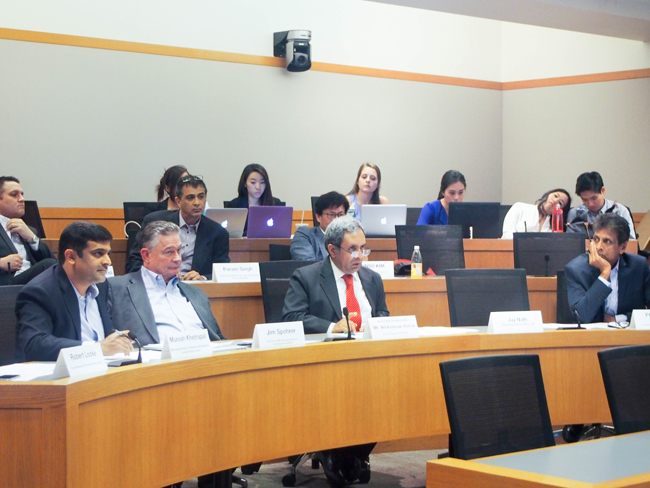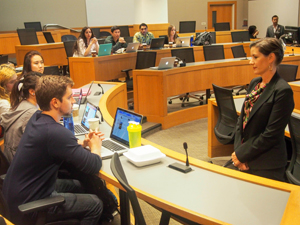
The panel of judges listen to presentations from Building Smart Cities teams. Center is Chief Judge: Ambassador Venkatesan Ashok, Consul General of India. Courtesy photo
CRIME MAPPING AND COMMUNITY GARDENS
After their two weeks in India, the student teams spent January through March analyzing what they had learned and creating solutions for the cities they visited. The ideas aimed to solve problems ranging from pollution to transportation to overcrowding to crime.
Team Oakland was working on crime solutions for the city they focused on in India. Ahmedabad faces the problem of high crime rates and an understaffed police department. “Safety-wise, Ahmedabad is better than cities like Delhi, but we realized it’s still lacking in the safety department,” said team member Isabelle Lee in a post on the school’s website. “We didn’t want to just advocate for more police.”
The team proposed three solutions. First, the team suggested using crime detection software from IBM. The software allows police departments to map where crimes happen and organize crimes by type. The idea is to remove police from lower-crime areas, based on crime rates.
Next, the team suggested using CrowdGauge, an open-source platform that turns complex political and social issues into games, to make the issues more understandable. Finally, the team proposed community garden projects to alleviate the issues of food deserts and poor access to healthy food.
On March 5 the Haas teams presented to the panel of leaders. Venkatesan Ashok, the San Francisco consul general of India, liked what he saw. A couple days later, Darwin was invited to present the student solutions to India’s Global Innovation Round Table.
As Darwin was presenting solutions to world leaders, the four student teams from his class were shifting their focus to the tech-saturated San Francisco Bay Area and the specific communities teams were named after—Berkeley, Oakland, San Francisco, and San Jose. The students met with mayors and leaders from each of the cities to learn about current infrastructure problems, and look into where open innovation, outcome-based business models, and development of smarter cities could create solutions.
MEETING WITH CITY LEADERS
The teams met with Berkeley Mayor Tom Bates and Oakland Mayor Libby Schaaf. The mayors told the teams what specific needs their respective cities had. Despite sharing a boundary, the needs of both communities are completely different, according to the mayors. Schaaf cited community safety, sustainable infrastructure, food and housing, and government transparency. Bates spoke of an aging infrastructure in dire need of maintenance and improvements.
“What are the social determinants of health—including employment and safety? How do you integrate the different races? How [can we] grow a permanent base if we cannot create confidence that Oakland will be safe and stay safe,” Schaaf reportedly asked the class. The teams worked together and with city leaders from Oakland, Berkeley, San Jose, and San Francisco to present their solutions on April 15. As with their March presentations, about half of their course grades were given by the panel members.
“Oakland is the best of what an American city can be,” Schaaf said in a prepared statement. “It’s diverse. It’s got architectural beauty. It’s got natural beauty. It’s got arts and gritty industry and a blue-collar aesthetic and incredible potential and opportunity for social movements, for entrepreneurs. It is America’s most exciting city.”












Questions about this article? Email us or leave a comment below.